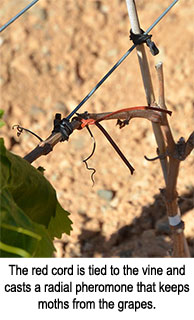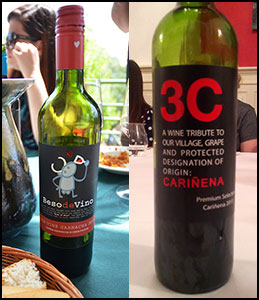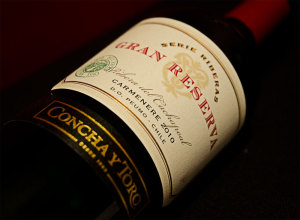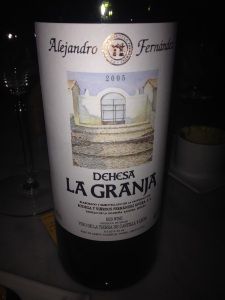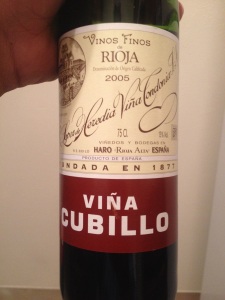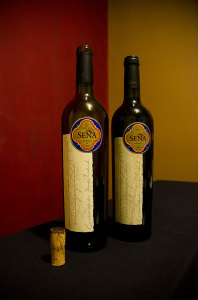Everybody loves the underdog.
Spain is a country with a rich wine history that spans many centuries. In 2014 it overtook the top spot for global exports, jumping ahead of Italy and France. At first glance, you would think that might be evidence of strong, positive trends. However, the reasons for having garnered that honor fly in the face of what many areas, particularly Cariñena, are trying to overcome: the vast majority of the output was simple, mass-production bulk sales. The reputation for being merely a quaffable drink provider is hard to shake, but what is bubbling in the outskirts of Zaragoza is a prime example of something that hints at a much more quality-driven trajectory that the entire can get behind.
On the attractive side of improvement, Spain has seen a wonderful surge of interest in the last few years with Cava becoming a popular go-to bubbly, Albariño and Godello from the northwest coast offering sea-breeze freshness, Mencia smoldering on chic wine geek radars, and then there’s always the shadow of Tempranillo, rising into beauty in the classic regions of Rioja and Ribera del Duero. However, with all this attention being spread around, you begin to get a clue as to why wineries in Cariñena are attempting to make a splash in the pool, as if to ask “is what we have here not just as exciting?” Sometimes, just because of the business nature of wine, you’ll find them trying to figure out how to appeal to their potential markets (particularly in the United States) when, in reality, it is us who should be actively eager to seek them out.
Winemaking here can be traced back to the 3rd century BC and it is one of the oldest regions to officially gain DO status is Spain. The more unique thing about Cariñena, though, is that the name refers to three distinct things: the name of the Denomination of Origin, the name of the town, and also the name of the grape: more widely known as Carignan, although it originally comes from this region. Grandes Vinos Y Viñedos, for instance, produces a fantastic bottling named “3C” specifically to make a point of this: Cariñena from Cariñena in Cariñena. That being said, this grape is certainly not the only one that the wineries here are profoundly excited about. Arguably, it plays second fiddle to the “Next Great Grape” of the region: Garnacha, which we also know from its French name: Grenache. It too traces its descendance to Spain. Cariñena has an angular potence and an incredibly firm yet regal structure. Garnacha offers a dense, spiced, fresh-pressed red fruit core while still showing vivacity. It’s exactly the kind of one-two punch that ought to distinguish a winemaking area, especially in the cases where both complement each other in the same bottle.
It is close to a universal wine tenet that elevation and age of vines tend to contribute some of the more profound and structural elements to wines. The depth of components they tend to elicit comes thanks to climatic conditions that allow substantial phenolic ripening as well as retention of acidity brought by cooler air temperatures, especially in the evening. High-altitude areas in Napa Valley, such as Howell Mountain, are prized because of the intensity that their elevation provides; recent popular interest in the reds of Etna in Sicily has also hinged heavily on altitude and vine age. In the same context, the idea that there is untapped potential in Cariñena isn’t just a fanciful notion; these vineyards are found at between 1300 to 2600 feet and vines regularly are 30-100 years old. To boot, there is a surge of viticultural and winemaking energy evident in many of the producers of the area who realize that there is excitement to be found in their multitude of soils, the history of their grapes, and particularly in the stout age of its sometimes centenarian vines, even as new plantings emerge in the area.
One of the more fantastical aspects of the elevation in Cariñena is how quickly soils can change even simply on the walk from the bottom of a hill slope to the top, never mind how it changes with just a short car ride. The diversity of soil types generally ranges from the rich, reddish clay-based earth of the lower lands to the sharp, stony slate of the higher vineyards to large, rounded, nearly galet-like rock-gardens where vines, most of which are not irrigated, struggle and consequently deliver gorgeous fruit. Yet, the one recurring thing you can’t but be impressed by is the balanced minerality in these wines that echoes the recurring sentiment of wanting to offer complexity and quality that is true to the region.
Cariñena seems to be in a phase where it’s beginning to understand the balance between classic ideas and adequate technology. On the one hand, you find an unashamed investment in quality modern equipment, the attention to aesthetics in how they focus on their wineries and office buildings, and a renegade desire to not be beholden to older winemaking regulations if it will impact the winemaking they feel can truly show what the area is all about. Yet, on the other hand, there is a concerted focus on minimalistic intervention in viticultural practices and on eliminating unnecessary chemical elements and focusing on sustainability.
For instance, despite what seemed to be an initially uncomfortable cost of implementation, wineries saw success upon collectively agreeing to undertake the insertion of pheromonal tags, which are placed on vines, in order to prevent the breeding of local moths that have been known to cause vineyard problems: a choice made with the mindset of avoiding insecticide alternatives when possible. You’ll also potentially happen upon 70 year old landowners in their vineyards still pruning the vines by hand in the scorching heat of the midday sun. The careful balance of both the classic and the modern is something emblematic of the area and it’s fantastic to see how that very same sentiment can be felt and tasted all the way through to the final wines.
With the multitude of rock soils, and in testament to the history and arduous work done in some of these remote vineyards, Cariñena wine has donned the name “El Vino de las Piedras”: wine of the stones. It is as much an assertion of pride in their own terroir as it is a perfect reflection of how the wines become. It’s not merely the continually prominent minerality that breathes through them, but what is striking about the character of these wines is how they are as a block of stone: meaning that the climatic and geographical conditions in the area (particularly the fierce Cierzo wind that rips through daily) make wines with intense, structured cores and upon these blocks do you find the winemakers individually becoming artists, chiseling out and carving away at their vinous liquids until the details and finesse show from underneath.
Despite all the arrows that point neatly towards an exciting nucleus here in the Cariñena DO, it is still an area that flies under the radar of many wine aficionados and it is for that very reason that it’s truly a ripe wonderland for wine geeks who are continually looking for the next vinous nook of the world ready to rise to prominence. With that in mind, perhaps Cariñena may not be the underdog much longer.
THE WINES
In the next segments I’ll be outlining my thoughts on a number of bottlings from the three wineries I had the honor to visit during my trip to Cariñena: Bodegas Paniza, Bodegas San Valero, and Grandes Vinos Y Viñedos. The Garnacha and Cariñena based wines of all three find beautiful consistency and quality. I make sure to drive home that point because I ended up finding some other marvelous gems on the outside of that perimeter as well, so while those two grapes are the heart and soul of Cariñena DO there’s still much more to enjoy. Cheers!
Bodegas Paniza
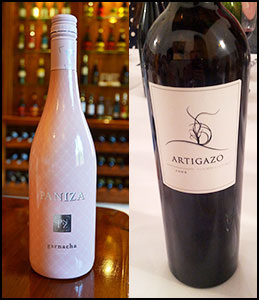 Bodegas Paniza, Rosé Garnacha 2014
Bodegas Paniza, Rosé Garnacha 2014
While they were understandably focused on showing off their powerful reds, the rosés from here ought not to be underestimated. Winemaker Antonio Serrano toyed with two different maceration lengths on rosés he’s been trying. This one sees 2 weeks and has both delicacy and vibrancy, showing spritely mango, cantaloupe, strawberry, orange peel, and incredible exotic body-spray aromatics while somewhat mimicking a Provence style but showing a richer fruit generosity. The bottle may be a bit cheeky (although it has market appeal) and the longer maceration rosé might be juicier, but this really rocks the lighter style while being fruity enough to appeal to summer drinkers.
Bodegas Paniza, Artigazo 2008
Their flagship bottling is a blend of 40% Garnacha, 30% Cabernet Sauvignon, and 30% Syrah. As you tend to find with Syrah and Grenache in other areas of the world, there’s a brooding smoked profile here of tobacco and charcoal, but it gets built up with a deep chocolate-covered berry profile. Dark florals, whiffs of mulled wine spices, and a hint of bay leaf round out a wine that’s still structurally massive (especially tannin-wise) even at 7 years of age. The density and the 18 months of aging in French oak make this a wine worth stashing for a bit.
Additional thoughts: The winery is the effective financial hub of the town of Paniza. It’s a huge responsibility, especially when you’re trying to blaze your own path. The wines, across the board, show fantastic promise. A 2013 oaked Cariñena of theirs that I tasted was incisive and fantastic, missing perhaps only a dense core of brooding juice to make it amazing. Coincidentally, we followed that wine with a 2014 Syrah that was all burly heft and you couldn’t help but wonder how they both might behave together. The energy and desire to jump into the limelight makes Bodegas Paniza a fun winery to follow as you suspect that once they develop a stride, things will explode.
Website: http://www.bodegaspaniza.com
Bodegas San Valero
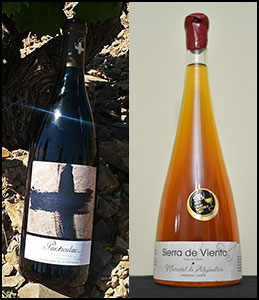 BSV, Particular Chardonnay/Moscatel 2014
BSV, Particular Chardonnay/Moscatel 2014
This sears with all the characteristics you’d expect for high altitude whites. There’s a wonderful mineral profile to this wine; it’s almost Bordeaux Blanc-like. The melding of that with the floral aromatics of the Moscatel and the just-ripe lemon, lime, and apple fruit gets further lifted by a bracing acidity. It’s not overtly deep, but the balance on this wine is outstanding. I will admit, for objectivity, that I experienced this wine by drinking it in the vineyard where the grapes were grown with the General Manager, the winemaker, and the vineyard owner…but the wine truly over-performs for what it is. I’d add this to the by-the-glass section of a wine list in a heartbeat.
Bodegas San Valero, Sierra de Viento, Late Harvest Muscat de Alexandria
It seems a bit unfair not to highlight one of BSV’s fantastic reds (the Particular Cariñena is “Particular-ly” lovely), but this dessert wine sung to me like a siren. Named after the famed fierce wind that blows in the town of Zaragoza, this amber beauty is a heavenly nectar of orange peel, citrus incense, aromatic oils, and clove wafting over a viscous orange creamsicle and tangy honey core. Sweet digestif wines are maybe always easy to fall for, but this was the first thing I made sure to grab at their store to bring back with me.
Additional thoughts: You genuinely get the sense of an honest communal kind of effort and involvement here, even with 700 associated winegrowers in their ranks. Unexpectedly running into one of the them in his vineyard as we were tasting the wine seemed to bring that sentiment into view clearly. Yet, the winery does not spare clinical effort, critical selection, and a willingness to embrace modernity and technology despite 71 years of history. The entire Particular lineup, which is being well-promoted, is a delicious and fantastic testament to this. The Particular Cariñena consistently performs well in reviews regardless of who is writing about it. Also, their Grand Ducay cava is a top-notch, serious taste of bubbly.
Website: http://www.sanvalero.com
Grandes Vinos Y Viñedos
In reality, the entire Beso line is one screaming value after another. I was actually already familiar with their Syrah-heavy Seleccion Especial, which boasts phenomenal meatiness and black fruit, but the Garnacha seems to show off all the reasons I think it often does better with less oak: peppered fresh wild strawberries that taste as if they were just pressed in old baskets and filtered just before savoring. Their Anayón Garnacha may garner more appeal because of the fantastic density (and the vineyard those grapes come from is gorgeous), but this is as pleasing a daily drinker as you’re likely to find.
Grandes Vinos Y Vinedos, “3C” 2013
I secretly wanted to lose my passport while staying in Zaragoza and Madrid, which was funny upon talking to winemaker Marcelo Morales, a Chilean native (which made me smile since I’d lived there in my youth), who confided that he had planned to stay in Spain for a year when first arriving. It’s now been 15. Stories aside, this 3C is really a kind of culmination of what the region is attempting to accomplish: echoing the DO, grape, and town all in one (as I’d mentioned earlier). The underlying structure underneath this wine nearly belies the fact that it’s refined with and elegance that works in tandem with the smoky black fruit.
Additional thoughts: The picturesque yet classic layout of the winery couldn’t be more apt an aesthetic to their wines. They showcased a tasting of Garnacha wines, each sampled from increasingly higher elevations and it was undeniably evident how much the altitude plays towards the sheer concentration of the wine. It was probably one of the best sensory indicators of why this region is a secret gem. Their entire Anayón lineup has rightly garnered plenty of praise and medals, but the barrel sample of the current-vintage Chardonnay we tasted showed particular precision and tension )thanks to the bracing minerality and acidity emblematic of the region) that tip-toes in balance against the rich, viscous nature of the juice this grape offers under good phenolic-ripening conditions, especially when French oak-aged.
Website: http://www.grandesvinos.com

